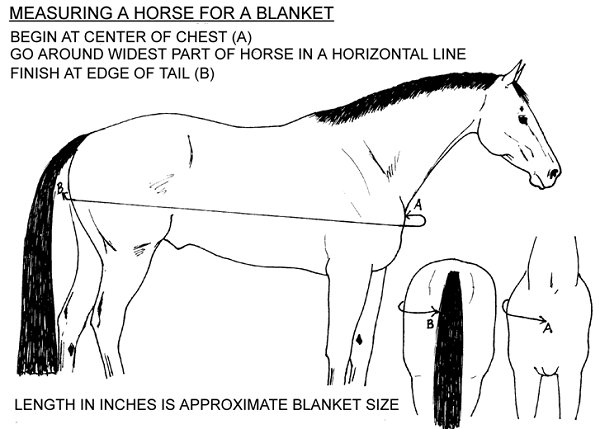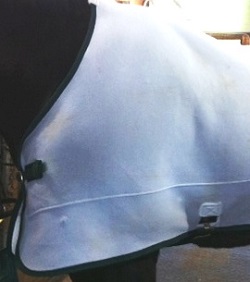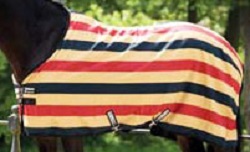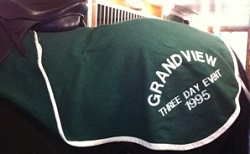 |
 |
 |
 |
| Blanket Selection |
| Typical requirements for Eastern Ontario/Quebec Winters |
| Situation | Indoor Needs | Outdoor Needs |
| Unclipped horse, outside most of the day, ridden lightly a couple of times a week | Unlined Sheet | Waterproof/Breathable Sheet |
Unclipped; turned out 2-3 hours/day; ridden lightly 4-5 days a week |
Lightweight Blanket | Waterproof/Breathable Lightweight Blanket |
Unclipped; turned out 1-2 hours/day; moderate work 4-5 days a week |
Midweight Blanket | Waterproof/Breathable Midweight Blanket |
Cipped or fine coat; turned out 1 hour/day; moderate work 6 days a week |
Heavyweight Blanket | Waterproof/Breathable Heavyweight Blanket |
| * These suggestions are for unheated stables ** Ridden horses should also have a cooler (fleece, Irish Knit, AirKnit, etc.), to wear while they dry off after work. | ||
| Fabrics and Terminolgy |
|
Denier: When you’re selecting outerwear for your horse, one of your first concerns may be the strength of the fabric. This is usually indicated in deniers. Denier simply refers to the thickness of the threads used to make the nylon fabric in the outer layer of the blanket, and it provides an indication of how durable the blanket will ultimately be. The higher the denier of the blanket, the heavier the fabric, and the stronger, more wind resistant and more water resistant the fabric is. Outer layers start at 300, and climb to a heavy, iron-wearing 2400. Most standard, quality turnouts are 1200 denier. Blanket linings range from 70 to 150 denier. Cordura: A synthetic nylon fabric that's highly resistant to abrasion, fungi, mold, mildew and rot. Heat setting and special coatings add such qualities as water-resistance or -proofing, and abrasion and tear resistance. Ballistic Nylon: Ballistic nylon is a thick and very tough synthetic fabric. It was originally designed for use in military jackets to protect the wearer from shell fragments and flying debris. More durable than Cordura, with the weights typically starting at 1050 denier. Rip-stop Nylon: Ripstop nylon refers to a high denier fabric that is woven in a crosshatch pattern that resists ripping and tearing. In the event a tear does occurs, the small squares prevent the hole from spreading and limit the damage to the blanket. It's used in applications where a lightweight, strong fabric is needed. the wearer from shell fragments and flying debris. More durable than Cordura, with the weights typically starting at 1050 denier. Water-resistant vrs waterproof: Water-resistant blankets and sheets provide some protection from moisture, but are not designed to keep a horse dry when it is exposed to downpours, snow or sleet for prolonged periods. Waterproof means that the blanket fabric has been treated to repel water for long periods. The water-proofing on a blanket does not last indefinitely - dirt and detergents can reduce its effectiveness, so blankets may have to be treated with a waterproofing spray or wash periodically to prolong their effectiveness. Breathability: Most blankets and sheets are made of breathable fabrics to allow body heat to escape. It should be noted that although some fabrics are labeled 'breathable', a horse produces a tremendous amount of heat and may sweat under a too-heavy blanket - leading you to think the blanket is not waterproof, when it is just too warm. Moisture-wicking: A fabric that is designed to transfer moisture from the horse’s skin and hair to the blanket, allowing the horse to dry. Moisture-wicking fabrics are mostly used in coolers. Insulation: Hollofil, hollow fiberfill, fiberfill, polyfill. All used to denote olefin, a polyester fiber that resists water, is machine washable, and offers a high insulation value at a light weight. Provides uniform warmth and firm consistency that maintains its shape. Used as the 'fill' in both indoor and outdoor blankets, a lightweight blanket may have up to about 150 grams of insulation; a midweight up to about 250 grams, and heavyweights may top 400 grams. |
| Blanket Fitting |
 |
Average Blanket Sizes |
| Blanket Care |
|
Unlined Sheets: Most stable sheets and synthetic coolers can be washed in a regular machine on the gentle cycle in cold water. Shake or brush off any loose dirt and hair, close any buckles and velcro pieces before washing, and do not overload the machine to allow for thorough rinsing. Hang to dry. Lined Blankets: Once linings are involved, washing blankets becomes more of a challenge as they become heavier, bulkier, and the linings may shift. It is safer to use a large, front loading machine, again on the gentle cycle in cold water. Shake or brush off any loose dirt and hair, close any buckles and velcro pieces before washing, and do not overload the machine to allow for thorough rinsing. Hang to dry. Wool Coolers: Wool and wool-blend coolers and quarter sheets are best sent for dry-cleaning periodically. Though they can sometimes be washed gently in cold with a wool detergent, the risk of shrinkage is high. Waterproof Turnouts: While dirt and abrasion can reduce the effectiveness of the waterproof properties of blankets, detergents also compromise their ability to keep your horse dry. For longest life, hang up dirty, wet blankets to dry and brush off the dried dirt and hair before the next use. Rainsheets can be 'washed' on gentle in a machine without detergent to keep them fresh, or you can use a 'reproofing' product in the machine, and then hang the blanket to dry. Heavier turnouts should be left to the professionals. Again, regularly brush off dried dirt and hair, and prior to storage for the summer, send them to be professionally cleaned. Once turnouts start to lose their water-repellancy, you can treat them with a product (found in hardware or camping stores) to restore their effectiveness. ** The above are guidelines only - most blankets come with washing instructions, and they should be followed for best results ** |
Blanket Reviews
 |
 |
| How does it look? |
| Gabrielle:"The Rambo Ionic Stable sheet looks great. The orange binding makes the sheet stand out of other stable sheets that can lay around the stable. The material seems (and is!) very durable and do not let down Rambo’s strive for quality and attention to details. The Ionic logo is very cool and gives a nice look to the blanket." |
| Joanne:"Nice colours." |
| Jess:"Really nice cut and flattering look but the colour (black and orange) makes me think of Halloween." |
| How does it fit? |
| Gabrielle:"Rambo’s Ionic Stable Sheets fits big. If your horse wears a 76’’ blanket, you should buy the 75’’ rather than the 78’’. The fact that the front of the blanket is not adjustable (compared to some other brands, which can be adjusted), makes it harder to fit horses perfectly. A part from that, the fit is great. The cut of the sheet is very classy and modern. It is made to fit the horses’ curves perfectly. It is not tight around any parts of the horses’ body, and does not rub on the withers." |
| Joanne:"It can be a bit tight in the shoulders and a bit 'skirty' in the back - like most Horseware blankets." |
| Jess:"My horse already has a Rambo stable sheet so I knew that the style would fit him well. I like that it's cut to sit high on the withers and doesn't slip back. My horse can be very fussy about fit and if the blanket gets tight or moves around he gets upset and tries to remove it or rub it on the walls. He very happily wore it all day long. " |
| How well did it function? |
| Gabrielle:"For trying the blanket only seven days, it is hard to say if the blanket actually did well to the horses. Of course, it did not cause anything bad. I think the results would be seen more in the long run than in the short-run. I had been using the Back On Track back warmer before and after my rides, on both horses. When we compare the Back On Track technology to the Ionic technology, I would say you cannot see the results as much with the Rambo. For example, when we put the Back On Track back warmer, you can actually feel the warmth coming out of the horse. With the Ionic Sheet, you cannot feel the warmth. Maybe the horse feels better, but it is hard to say how well it functions in a short period of time. Also, it is not mentioned the amount of time that it should be put on the horse. If they had a guide, maybe we could see a real progression in the horse’s training." |
| Jess:"There is no introductory period with the ionic blanket like there is with the Back on Track so I immediately left it on my horse all day (with supervision). He didn't get hot and seemed comfortable so I left it on for 10-12 hours a day. He is a very expressive, sensitive horse and was very calm and happy to wear it. After 2 days, there was already a difference in his movement and relaxation during work. He was quicker in his hind end and was more willing to stretch over his topline. He is always a bit tight in his left shoulder/right hind and that was greatly reduced. I found it hard to believe that there was such a difference in such a short period of time, but there was! |
| What didn't you like? |
| Gabrielle:"What I did not like about the sheet is that, since it covers the horses’ complete body, it should have the Ionic technology where the shoulders are, not only where the back is. Therefore, the horse will get a more complete treatment than only the back. The other thing that I would recommend changing is a wipe-clean tail cord. I own the Rambo Optimo Stable sheet and it has it, so why would the Ionic (which is priced higher than the Optimo), not have it? Plus, as I mentioned before, I dislike the fact that the front of the blanket is not fully adjustable. If it was, it could fit more horses better on the withers, although the Rambo sheets are very well designed in order for the horse to be able to move freely while wearing the sheets. Finally, as I have also mentioned previously, the fact that we cannot see an immediate change in the horse, compared to the Back On Track technology bothers me a little bit. But as I said, in the long-run, the sheet might turn out to be great." |
| Joanne:"The construction seems a bit light and it was too tight in the shoulders." |
| Jess:"I think the blanket material could have been a bit more robust, the other Rambo sheets seem more sturdy. " |
| Would you recommend it? |
| Gabrielle:"After trial, I would recommend the sheet because it looks great, and since Rambo is a very well established company in the equestrian world, I am sure it does great to horses. The ceramic/tourmaline technology had been proven, I think it is a great idea to have Rambo introduce a sheet like this. The only problem I see is the introductory period, because I do not believe the sheet should be left on for a complete day at first, but I also think that only an hour of wearing the sheet will not cause any dramatic change in the horse’s body. I think this is a point that should be discussed at Horseware." |
| Joanne:"If Horseware blankets fit your horse, then probably." |
| Jess:" Absolutely! My horse is short backed, high strung and opinionated. He was soon moving better, was more relaxed and quicker to warm up. I knew he would be a good trial candidate for this blanket because I've tried a lot of different things with him and it's very easy to see what works and what doesn't. He definitely let me know that this blanket should be added to our collection! " |
| Is the price reasonable? |
| Gabrielle:"The price is reasonable. The Back On Track stable sheet sells for approximately the same price ... Knowing that Rambo is a very high-class brand in the equestrian world, I think the price reflects the quality." |
| Joanne:"Yes." |
| Jess:" Yes. It is a good quality blanket, there was a good effect and it's a comparable price to other therapeutic blankets. " |
| Thank you Gabrielle, Joanne, and Jess! |
| Back to Rambo Ionic Products |
| "Tracey's Tackbox" - Blanket Favourites | |
 |
As the latest and greatest blankets hit the store shelves, I re-examine the blankets I use on my own horses – and why. |
| The blanket I get the most use from all year round is my Ecogold Air-Knit Cooler. This honeycomb-type fabric is the most
effective cooler I’ve ever used to dry a wet horse - letting air circulate around the horse without allowing him to get
chilled. It isn't too heavy for any but the hottest weather, so I often use it as a travelling blanket; if my horse sweats
up a bit when shipping he doesn’t overheat and he can then cool down without getting cold. The downside is it is white,
so it's a bit stained as it's been left on in the stall and out in the paddock at times! They are easy to wash in the
machine and quick to dry, long-lasting (I’ve had mine over 10 years) and the bit of stretch to the material seems to be
comfortable on the horse. Ecogold doesn't make them anymore, but Horseware has the AirMax cooler, which is the same thing. It's the one cooler I wouldn't give up. | |
 |
I think the Rambo line of blankets from Horseware are designed really well, so my favorite stable sheet and blanket are the old Rambo Newmarket ones. |
| They have changed from the stripes to solid colours, and 'upgraded' the lining from a polyester
(which didn`t rub or cause static electricity) to a type of microfiber that is nice and smooth - so far they seem to be performing well.
They are lightweight and fit in my standard washing machine easily, and they dry quickly when hung up. The blankets that a horse wears
for long periods of time are the most critical to get a really good fit on or you are asking for rubs, rips, and possibly a
very cranky horse. The neck and shoulder area are the most important, and gussets and a lot of adjustment are not always necessary if the shape
is correct to start with. The different manufacturers tend to work with similar patterns for their various models, so when you find a company that
makes one that fits your horse well, you are likely to have success with others in their line-up - my rainsheet is also from Horseware, a Rhino Wug. | |
 |
The last of my favourites (for now!) is an old Melton wool quarter sheet won at the Grandview Event in 1995. It happened to be hunter green (my stable colours) and the medium size has worked on all my horses. |
| It is the old-style square version rather than the key-hole type you can remove, but I'm only using it on clipped horses or when it's really cold, so I tend to leave it on while I ride anyway. It's a good weight and I don't have to worry about static electricity like you can get from some of the lovely fleece blankets. I wash it once or twice a year in cold water with a mild detergent on the gentle cycle, and hang it up to dry. I admit that it has considerable sentimental value, and can be a bit of a motivational tool when tacking up for a schooling session on a dark, frigid day in February! | |
| Back to: Top of Page - Blankets - Archives |
